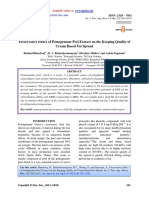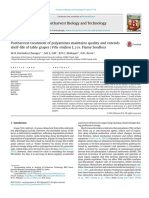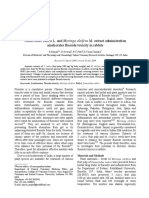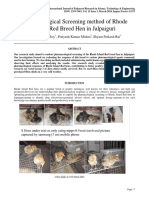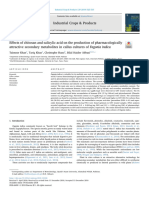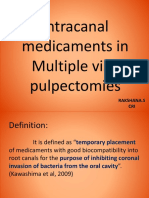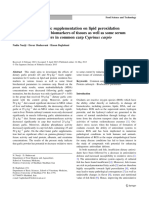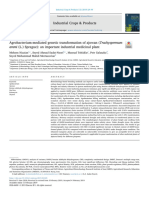0 ratings0% found this document useful (0 votes)
56 viewsMeat Irradiation: Evidente, Ralph Carlo T. Loresca, Daniel Eldrei D
Meat Irradiation: Evidente, Ralph Carlo T. Loresca, Daniel Eldrei D
Uploaded by
Ralph EvidenteGamma irradiation was found to reduce the microbial load and improve the quality characteristics of veal. Irradiation of veal at doses up to 3 kGy significantly reduced populations of microorganisms like Staphylococcus aureus and total aerobic bacteria. Irradiated veal also showed improved organoleptic characteristics and color retention compared to non-irradiated veal over storage time. The study concluded that irradiation is an effective method for decontaminating veal and reducing pathogens to increase safety while maintaining quality.
Copyright:
© All Rights Reserved
Available Formats
Download as PPTX, PDF, TXT or read online from Scribd
Meat Irradiation: Evidente, Ralph Carlo T. Loresca, Daniel Eldrei D
Meat Irradiation: Evidente, Ralph Carlo T. Loresca, Daniel Eldrei D
Uploaded by
Ralph Evidente0 ratings0% found this document useful (0 votes)
56 views6 pagesGamma irradiation was found to reduce the microbial load and improve the quality characteristics of veal. Irradiation of veal at doses up to 3 kGy significantly reduced populations of microorganisms like Staphylococcus aureus and total aerobic bacteria. Irradiated veal also showed improved organoleptic characteristics and color retention compared to non-irradiated veal over storage time. The study concluded that irradiation is an effective method for decontaminating veal and reducing pathogens to increase safety while maintaining quality.
Original Description:
RESULTS
Original Title
Meat Irradiation
Copyright
© © All Rights Reserved
Available Formats
PPTX, PDF, TXT or read online from Scribd
Share this document
Did you find this document useful?
Is this content inappropriate?
Gamma irradiation was found to reduce the microbial load and improve the quality characteristics of veal. Irradiation of veal at doses up to 3 kGy significantly reduced populations of microorganisms like Staphylococcus aureus and total aerobic bacteria. Irradiated veal also showed improved organoleptic characteristics and color retention compared to non-irradiated veal over storage time. The study concluded that irradiation is an effective method for decontaminating veal and reducing pathogens to increase safety while maintaining quality.
Copyright:
© All Rights Reserved
Available Formats
Download as PPTX, PDF, TXT or read online from Scribd
Download as pptx, pdf, or txt
0 ratings0% found this document useful (0 votes)
56 views6 pagesMeat Irradiation: Evidente, Ralph Carlo T. Loresca, Daniel Eldrei D
Meat Irradiation: Evidente, Ralph Carlo T. Loresca, Daniel Eldrei D
Uploaded by
Ralph EvidenteGamma irradiation was found to reduce the microbial load and improve the quality characteristics of veal. Irradiation of veal at doses up to 3 kGy significantly reduced populations of microorganisms like Staphylococcus aureus and total aerobic bacteria. Irradiated veal also showed improved organoleptic characteristics and color retention compared to non-irradiated veal over storage time. The study concluded that irradiation is an effective method for decontaminating veal and reducing pathogens to increase safety while maintaining quality.
Copyright:
© All Rights Reserved
Available Formats
Download as PPTX, PDF, TXT or read online from Scribd
Download as pptx, pdf, or txt
You are on page 1of 6
MEAT IRRADIATION
Evidente, Ralph Carlo T.
Loresca, Daniel Eldrei D.
Effects of gamma irradiation on
microbial load and quality
characteristics of veal
Ebrahim Rahimi, Reza Faghihi, Milad Baradaran-Ghahfarokhi,
Ali Alavaian-Ghavanini, Hamid Reza Baradaran-Ghahfarokhi,
Zahra Siavashpour, Afrouz Farshadi, Farzad Rafie
Results and Discussion
Results and Discussion
Results and Discussion
Conclusion
Correct hygiene activities can reduce the microbial load of veal and other veal
products during production and processing.
Lack of modern slaughterhouses in many regions of Iran increases meat microbial
load.
Decontaminating food items through irradiation is considered as a reliable, effective,
and healthy method in deactivating microbial toxins as well as in eradicating
pathogenic microorganisms.
These results indicated that irradiation could be employed as an effective mean to
inactivate common food-borne pathogens namely S. aureus and increases the half
life of veal.
You might also like
- L4.2 Product FormationDocument16 pagesL4.2 Product FormationRalph EvidenteNo ratings yet
- Food Bioscience: A A A B CDocument9 pagesFood Bioscience: A A A B CNhật Nguyễn SĩNo ratings yet
- PDocument21 pagesPRebecca ChenNo ratings yet
- Ijpab 2017 5 6 323 328Document6 pagesIjpab 2017 5 6 323 328Dr patange dnyaneshwarNo ratings yet
- Functional and Antioxidant Properties of Novel Snack Crackers Incorporated With Hibiscus Sabdariffa By-ProductDocument9 pagesFunctional and Antioxidant Properties of Novel Snack Crackers Incorporated With Hibiscus Sabdariffa By-ProductDBNo ratings yet
- Pankajpable..report - Docx 20240520 180717 0000Document42 pagesPankajpable..report - Docx 20240520 180717 0000pankaj pableNo ratings yet
- What Does 1% Horse DNA Mean Testing For DNA: ForeignDocument24 pagesWhat Does 1% Horse DNA Mean Testing For DNA: ForeignSonu SomanathNo ratings yet
- Effect of Natural Antioxidant Extracts On Oxidative and Microbiological Stability of Beef BurgerDocument15 pagesEffect of Natural Antioxidant Extracts On Oxidative and Microbiological Stability of Beef Burgerعلي الراويNo ratings yet
- Postharvest Biology and Technology: W.A. Harindra Champa, M.I.S. Gill, B.V.C. Mahajan, N.K. AroraDocument7 pagesPostharvest Biology and Technology: W.A. Harindra Champa, M.I.S. Gill, B.V.C. Mahajan, N.K. AroraHarshitMittalNo ratings yet
- Journal of The Saudi Society of Agricultural SciencesDocument7 pagesJournal of The Saudi Society of Agricultural SciencesWarren Dela CernaNo ratings yet
- 1 s2.0 S0377840122003017 MainDocument17 pages1 s2.0 S0377840122003017 Mainbulelani.pepetaNo ratings yet
- Antioksidan AntibakterialDocument8 pagesAntioksidan AntibakterialAprilihardini LaksmiNo ratings yet
- Cultivation of Chlorella Vulgaris in Non-Sterilized Tofu Wastewater Anaerobic Digestion EffluentDocument9 pagesCultivation of Chlorella Vulgaris in Non-Sterilized Tofu Wastewater Anaerobic Digestion EffluentPuspa HikmantyNo ratings yet
- Farm Bio-Security With Nano Silver Hydrogen Peroxide Based Alstasan SilvoxDocument2 pagesFarm Bio-Security With Nano Silver Hydrogen Peroxide Based Alstasan SilvoxSilver Hydrogen PeroxideNo ratings yet
- Milk Ring, Rose Bengal Tests and Conventional PCR Based Detection of Brucella Abortus Infected Dairy Cattle in BangladeshDocument6 pagesMilk Ring, Rose Bengal Tests and Conventional PCR Based Detection of Brucella Abortus Infected Dairy Cattle in Bangladeshsafna mariyamNo ratings yet
- Effect of Moringa Oleifera On Hematological Parameters of Calves Reared in Industrial Fluorotic AreaDocument6 pagesEffect of Moringa Oleifera On Hematological Parameters of Calves Reared in Industrial Fluorotic AreaCitra Ayu ApriliaNo ratings yet
- Chemical Composition, Antioxidant, and Antimicrobial Activities of P. Roxburghii Oleoresin Essential Oils Extracted by Steam Distillation, Superheated Steam, and Supercritical Fluid CO2 ExtractionDocument14 pagesChemical Composition, Antioxidant, and Antimicrobial Activities of P. Roxburghii Oleoresin Essential Oils Extracted by Steam Distillation, Superheated Steam, and Supercritical Fluid CO2 Extractionmuhammad adnan ayubNo ratings yet
- Fresh GingerDocument12 pagesFresh GingerEmerald Falah BrayogaNo ratings yet
- Ijeb 47 (11) 900-905Document6 pagesIjeb 47 (11) 900-905Hitesh VermaNo ratings yet
- 10.2478 - Aoas 2024 0042Document31 pages10.2478 - Aoas 2024 0042PramaNo ratings yet
- Pharmacological Screening Method of Rhode Island Red Breed Hen in JalpaiguriDocument3 pagesPharmacological Screening Method of Rhode Island Red Breed Hen in JalpaiguriMr.S. p.royNo ratings yet
- Pengaruh Kitosan Dan Asam Salisilat Terhadap Produksi Metabolit Sekunder Yang Menarik Secara Farmakologis Pada Kultur Kalus Fagonia IndicaDocument11 pagesPengaruh Kitosan Dan Asam Salisilat Terhadap Produksi Metabolit Sekunder Yang Menarik Secara Farmakologis Pada Kultur Kalus Fagonia IndicahasanNo ratings yet
- DownloadDocument8 pagesDownloadtalhaNo ratings yet
- Intracanal Medicaments in Multiple Visit Pulpectomies: Rakshana.S CRIDocument26 pagesIntracanal Medicaments in Multiple Visit Pulpectomies: Rakshana.S CRIRakshana RakshuNo ratings yet
- Validated Method For Quality Assessment of Henna (Lawsonia Inermis L.) Leaves After Postharvest Blanching and Its Cosmetic ApplicationDocument10 pagesValidated Method For Quality Assessment of Henna (Lawsonia Inermis L.) Leaves After Postharvest Blanching and Its Cosmetic ApplicationTuấn Nguyen AnhNo ratings yet
- Uses of Salvadora Persica L. (Chewing Sticks) As A Therapeutic To Inflammation PeriodontalDocument9 pagesUses of Salvadora Persica L. (Chewing Sticks) As A Therapeutic To Inflammation PeriodontalSarah Ariefah SantriNo ratings yet
- Dietary Spirulina Platensis and Chlorella Vulgaris Effects On Survival and Haemato-Immunological Responses of Clarias Gariepinus Juveniles ToDocument19 pagesDietary Spirulina Platensis and Chlorella Vulgaris Effects On Survival and Haemato-Immunological Responses of Clarias Gariepinus Juveniles ToMasBayuSyamsunarnoNo ratings yet
- Food Chemistry: Rajeev Ravindran, Amit K. Jaiswal TDocument6 pagesFood Chemistry: Rajeev Ravindran, Amit K. Jaiswal TJavier MoisésNo ratings yet
- Effect of Dietary Garlic Supplementation On Lipid PeroxidationDocument7 pagesEffect of Dietary Garlic Supplementation On Lipid Peroxidationbadrinizar00No ratings yet
- 1 s2.0 S0926669019300974 MainDocument12 pages1 s2.0 S0926669019300974 MainPuput NurlizanNo ratings yet
- Molecular Identification and Biological Control of Ralstonia SolanacearumDocument15 pagesMolecular Identification and Biological Control of Ralstonia SolanacearumHvzem MohammedNo ratings yet
- Tmpa586 TMPDocument9 pagesTmpa586 TMPFrontiersNo ratings yet
- Pepper NigrumDocument11 pagesPepper NigrumafridiNo ratings yet
- Rodriguez Lazaro2014Document8 pagesRodriguez Lazaro2014Yonatan PestanaNo ratings yet
- Effectiveness of Oxytetracycline in Reducing The Bacterial Load in Rohu Fish (Labeo Rohita, Hamilton) Under Laboratory Culture ConditionDocument6 pagesEffectiveness of Oxytetracycline in Reducing The Bacterial Load in Rohu Fish (Labeo Rohita, Hamilton) Under Laboratory Culture ConditionJose SilvaNo ratings yet
- Effects of Supplementing Broiler Diets With Coriander Seed Powder On Growth Performance, Blood Haematology, Ileum Microflora and Economic EfficiencyDocument10 pagesEffects of Supplementing Broiler Diets With Coriander Seed Powder On Growth Performance, Blood Haematology, Ileum Microflora and Economic EfficiencybandayNo ratings yet
- Multiplex PCRDocument5 pagesMultiplex PCRyuniarianaNo ratings yet
- Toxics 12 00194Document14 pagesToxics 12 00194angelcorbett222No ratings yet
- Comparative Analysis. Evs. of Edible Oil Qualitysnnanna in FisDocument1 pageComparative Analysis. Evs. of Edible Oil Qualitysnnanna in FisShah RameezNo ratings yet
- Basharat Et Al 2023Document17 pagesBasharat Et Al 2023Farhat WaseemNo ratings yet
- The Effect of Oven Time Using Household OvenDocument12 pagesThe Effect of Oven Time Using Household OvenafikNo ratings yet
- Analysis of Multi-Residue Pesticides Content in Oriens®Premium Garlic and Its Safety ValidationDocument3 pagesAnalysis of Multi-Residue Pesticides Content in Oriens®Premium Garlic and Its Safety ValidationmatitaputyNo ratings yet
- Physico Chemical Analysis and Antimicrobial Potential of Apis DorsataDocument9 pagesPhysico Chemical Analysis and Antimicrobial Potential of Apis DorsataAbuzar ZunnaiyyerNo ratings yet
- 1 s2.0 S2212670813000924 MainDocument5 pages1 s2.0 S2212670813000924 MainJohanValleIngaNo ratings yet
- ConfpropolisDocument16 pagesConfpropolisMostapha BelNo ratings yet
- PIIS2405844024016384Document19 pagesPIIS2405844024016384veszterNo ratings yet
- MicrobialDocument1 pageMicrobialsfgvsdfrbhNo ratings yet
- Nutritive Value of Several Raisin By-Products For Ruminants Evaluated by Chemical Analysis and in Situ Ruminal DegradabilityDocument8 pagesNutritive Value of Several Raisin By-Products For Ruminants Evaluated by Chemical Analysis and in Situ Ruminal DegradabilityMohamed MahmoudNo ratings yet
- Talanta: SciencedirectDocument6 pagesTalanta: Sciencedirectmelimeli106No ratings yet
- INHAC2016 Publ2018Document19 pagesINHAC2016 Publ2018Muhammad Faqih MukhlisinNo ratings yet
- Screening Porcine DNA in Collagen Cream Cosmetic ProductsDocument6 pagesScreening Porcine DNA in Collagen Cream Cosmetic ProductsFarida Putri SyayarohNo ratings yet
- Aquaculture S 21 02050Document31 pagesAquaculture S 21 02050Md Zaved Hossain KhanNo ratings yet
- Application of The Folin-Ciocalteu Method To The Evaluation of Salvia Sclarea ExtractsDocument7 pagesApplication of The Folin-Ciocalteu Method To The Evaluation of Salvia Sclarea ExtractsIzzat ZakwanNo ratings yet
- CCD HPLTCDocument8 pagesCCD HPLTCanisah100% (1)
- Antioxidant and Antimicrobial Effects of Rosemary and Ginger Extract Added To Karadi Yearling Lamb PattiesDocument7 pagesAntioxidant and Antimicrobial Effects of Rosemary and Ginger Extract Added To Karadi Yearling Lamb PattiesLuizaNo ratings yet
- 10 1080@1354750x 2020 1737734Document31 pages10 1080@1354750x 2020 1737734Said BabouNo ratings yet
- Purification and Characterization of Hyaluronic Acid Produced by Streptococcus Zooepidemicus Strain 35Document8 pagesPurification and Characterization of Hyaluronic Acid Produced by Streptococcus Zooepidemicus Strain 35Barbara OlmosNo ratings yet
- Genetic Diversity Analysis of Zingiber O Cinale Roscoe by RAPD Collected From Subcontinent of IndiaDocument7 pagesGenetic Diversity Analysis of Zingiber O Cinale Roscoe by RAPD Collected From Subcontinent of IndiaMuhammad Abdur RokhimNo ratings yet
- 1 s2.0 S0362028X23068394 MainDocument11 pages1 s2.0 S0362028X23068394 Mainjorge_bustos_1No ratings yet
- Lesson 1 Writing The IntroductionDocument11 pagesLesson 1 Writing The IntroductionRalph EvidenteNo ratings yet
- OpenFOAM Foundation Handout PDFDocument92 pagesOpenFOAM Foundation Handout PDFRalph EvidenteNo ratings yet
- Blockmeshdict PDFDocument73 pagesBlockmeshdict PDFRalph EvidenteNo ratings yet
- Blockmeshdict PDFDocument73 pagesBlockmeshdict PDFRalph EvidenteNo ratings yet
- L3.1 - Enzyme Immobilization SystemsDocument60 pagesL3.1 - Enzyme Immobilization SystemsRalph EvidenteNo ratings yet
- Cover LetterDocument1 pageCover LetterRalph EvidenteNo ratings yet
- L3.2 Immobilized Enzyme KineticsDocument98 pagesL3.2 Immobilized Enzyme KineticsRalph Evidente100% (2)
- Philippine Drug Wa1Document13 pagesPhilippine Drug Wa1Ralph EvidenteNo ratings yet
- Determination of Rate of EvaporationDocument4 pagesDetermination of Rate of EvaporationRalph EvidenteNo ratings yet
- ReportDocument2 pagesReportRalph EvidenteNo ratings yet
- Ideal Otto CycleDocument3 pagesIdeal Otto CycleRalph EvidenteNo ratings yet
- Enzyme Immobilization BiocheDocument11 pagesEnzyme Immobilization BiocheRalph EvidenteNo ratings yet
- Previous ExamDocument15 pagesPrevious ExamRalph EvidenteNo ratings yet
- Appendix I. Raw Data Table A.1 Raw DataDocument2 pagesAppendix I. Raw Data Table A.1 Raw DataRalph EvidenteNo ratings yet
- CHE142-1 SyllabusDocument6 pagesCHE142-1 SyllabusRalph EvidenteNo ratings yet
- Energy: Increased in Worldwide Consumption of Energy Has Led To A Search For New Energy Sources For The FutureDocument18 pagesEnergy: Increased in Worldwide Consumption of Energy Has Led To A Search For New Energy Sources For The FutureRalph EvidenteNo ratings yet
- EVIDENTE, Ralph Carlo T.: ObjectiveDocument1 pageEVIDENTE, Ralph Carlo T.: ObjectiveRalph EvidenteNo ratings yet
- Problem 3.17Document6 pagesProblem 3.17Ralph Evidente100% (1)
- DelRosario Ernesto 2013 CVDocument28 pagesDelRosario Ernesto 2013 CVRalph EvidenteNo ratings yet
- Xray Sedimentation 3Document17 pagesXray Sedimentation 3Ralph EvidenteNo ratings yet
- Umami: Evidente, Ralph Carlo Reyes, Carl SamuelDocument11 pagesUmami: Evidente, Ralph Carlo Reyes, Carl SamuelRalph EvidenteNo ratings yet



